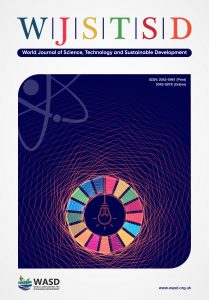Developing local processing technology for black and green tea and evaluation of conformance to ISO standard, Dr. Olusegun Aroyeun, Prof. Gerald Iremiren, Dr. Samuel Omolaja, Dr. Feyisara Okelana, Dr. Olayiwola Olubamiwa, Dr. Rotimi Ipinmoroti, Amos Oloyede, Dr. Semiu Olalekan, Daniel Andrew, Christiana Jayeola, Dr. Fatai Sowunmi and Lukman Odumbaku
 Dr. Olusegun Aroyeun, Prof. Gerald Iremiren, Dr. Samuel Omolaja, Dr. Feyisara Abiodun Okelana, Dr. Olayiwola Olubamiwa, Dr. R.R. Ipinmoroti, Amos Oloyede, Dr. Semiu Ogunwolu Olalekan, Daniel Andrew, Christiana Olayinka Jayeola
Dr. Olusegun Aroyeun, Prof. Gerald Iremiren, Dr. Samuel Omolaja, Dr. Feyisara Abiodun Okelana, Dr. Olayiwola Olubamiwa, Dr. R.R. Ipinmoroti, Amos Oloyede, Dr. Semiu Ogunwolu Olalekan, Daniel Andrew, Christiana Olayinka Jayeola
Cocoa Research Institute of Nigeria, Ibadan
Nigeria
Email: aroyeun2000@yahoo.co.uk
Dr. Fatai Abiola Sowunmi
Department of Agricultural Economics
Lagos State University, Ojo
Nigeria
Lukman Ola Odumbaku
Moshood Abiola Polytechnic, Abeokuta
Nigeria
DOI: 10.1108/20425941211271513
Purpose: The purpose of this paper is to describe a project designed with the aim of developing a black and green tea processing technology for Nigerian farmers and evaluate the conformance of the quality of the processed tea to the recommended international standard.
Design/methodology/approach: Locally processed and graded black teas were collected from Kakara and Bangoba for analysis. Different grades analyzed were Dust 1, Pekoe fanning (PF), broken pekoe (BP) and Fibre. Green tea was also processed from 21 tea clones selected from the Cocoa Research Institute, Kusuku Station tea plantation located at 1,840 m above mean sea level and analyzed for quality characteristics. The methods used for the quality of black and green teas analysis were in accordance with ISO standard: ISO 9768 method (revised) was used for determining % water extract, ISO 5498 for crude fibre, ISO 1575 for % total ash, and ISO 1577 for acid insoluble ash. Other additional quality parameters evaluated for black tea were theaflavins (TF), thearubigins (TR) and colour brightness (C Br) from another set of 17 clones using flavonost methods. Conformance to ISO standard were assessed in all tea locally processed by the farmers, in comparison to the ones processed under controlled conditions.
Findings: The results obtained in this study revealed that 59.2 per cent of the tea analyzed conformed to ISO 9768, 81.5 per cent to ISO 5498, 77.8 per cent to ISO 1575 and 96.3 per cent to ISO 1576 and 100 per cent conformed to ISO 1577 and 85.2 per cent to ISO 1578 respectively. In all, only 33 per cent of the processed tea conformed to international standard for black or green tea physical parameters. As for black tea, clones which conformed to correct TF, TR, CBR are UNK, 367, 19, 74, 354, 368, 369, 353, 357, 143, 14 and 108 respectively.
Practical implications: The paper shows that production of green tea and black tea can be done locally without loss of quality if good manufacturing practices and hygiene practices are followed.
Originality/value: The use of clonal materials sourced locally that conformed to ISO standard from Nigeria could create new products (black and green tea) with high economic values to the farmers.
Keywords: Nigeria; Agriculture; Tea; Food technology; Quality standards; ISO; Tea quality; Theaflavins; Thearubigins; Colour brightness; Conformance.
Citation: Aroyeun, O., Iremiren, G., Omolaja, S., Abiodun Okelana, F., Olubamiwa, O., Ipinmoroti, R.R., Oloyede, A., Ogunwolu Olalekan, S., Andrew, D., Olayinka Jayeola, C., Abiola Sowunmi, F. and Ola Odumbaku, L. (2012), "Developing local processing technology for black and green tea and evaluation of conformance to ISO standard", World Journal of Science, Technology and Sustainable Development, Vol. 9 No. 4, pp. 317-324. https://doi.org/10.1108/20425941211271513

